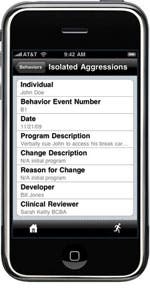As the “App Revolution” continues to gain steam, users are beginning to expect that there’s an app for just about anything they want to do. While there are apps for virtually every niche or mainstream aspect of a user’s personal life, there’s a significant void when it comes to apps for a user’s professional life—especially as it relates to large corporate environments. Information workers continue to do more and more of their job while they’re on the go. However, most of the data and applications they need to be productive are still only accessible to them from a desktop or laptop computer.
Why develop internal applications?
Ask almost any gathering of CIOs if, within the next five years, enterprise users will be able to access the same data and applications on their smartphone as they can from their desktop/laptop. You’ll receive an almost unanimous “Yes.” That’s not to say that getting from here to there won’t be a challenge, but awareness of the need for this among both corporate users and executive management is great. We’re very close to reaching the tipping point necessary for widespread adoption.
When information workers have complete mobile access to the business data and applications necessary to do their job, both productivity and employee satisfaction are often dramatically improved. Initially, mobile applications provide significant competitive advantages to the early adopters. But in the same way mobile e-mail went mainstream, internal mobile applications will simply become a necessary cost of doing business for companies in many different industries.

What kinds of applications?
 As with the rest of the app universe, the sky is the limit as far as enterprise apps are concerned. We can expect to see apps for expense reporting, time tracking, business intelligence, proof-of-delivery, executive dashboards, survey capture, transaction processing, field service, sales force automation, and more. Rather than thinking about these apps as mobile versions of existing solutions, results are often much more productive if the application is designed from the perspective of the mobile worker. He or she may only need a small subset of existing functionality, augmented by new functionality made possible by the mobile capabilities of the device (i.e. GPS, barcode scanning, accelerometer, camera, etc.).
As with the rest of the app universe, the sky is the limit as far as enterprise apps are concerned. We can expect to see apps for expense reporting, time tracking, business intelligence, proof-of-delivery, executive dashboards, survey capture, transaction processing, field service, sales force automation, and more. Rather than thinking about these apps as mobile versions of existing solutions, results are often much more productive if the application is designed from the perspective of the mobile worker. He or she may only need a small subset of existing functionality, augmented by new functionality made possible by the mobile capabilities of the device (i.e. GPS, barcode scanning, accelerometer, camera, etc.).
However, a business environment places many more limitations on a corporate user than on a private individual user. Access to data, security, manageability, and availability of mobile integration points out that back-end systems constrain the mobile potential of an organization.
The Evergreen Center developed and deployed this internal app called DataPoint on both iPhones and iPod touches to record observations of skills and behaviors of students with developmental disabilities.
iPhone vs. iPod touch
The iPod touch is starting to become very popular for internal mobile applications like data collection and survey capture that have traditionally been deployed on PDAs or ruggedized handhelds. In fact, Apple Store sales reps now use the iPod touch to ring up customer purchases (see the full article on page 77). Because the “touch” does not require a wireless data plan, the cost of deploying an internal application on one, verses an iPhone, is extremely compelling.
If the application does not require a constant data connection, or if it is used in a physical location with a range of Wi-Fi access points, there is often very little downside to deploying the application on an iPod touch. It’s also becoming more common to use mobile hotspots (like the MiFi from Verizon Wireless) to provide remote connectivity to one or more mobile workers. It will be very interesting to see how the market continues to evolve with the adoption and deployment of this type of device.
Riding the wave of mobility
Given the explosive growth of the ecosystem surrounding the App Store, it’s not surprising that the vast majority of apps are not oriented towards business. Those that are, are often less sophisticated than what most organizations expect of their business software. Fortunately, the sophistication of business apps and the number of them available in the App Store are growing dramatically. And as more apps become available, an ever-growing collection of business problems are solved. Still, there will always be situations in which a product simply isn’t available, and the organization must develop their own internal app.
Embracing mobility within your organization is an ongoing process, and success cannot be achieved overnight. Start small with your internal app strategy and get feedback from users throughout the entire ideation and development process. Plan the pilot deployment carefully, build on early successes, and most importantly, make sure that it solves a problem for your users and provides real value to the business.
As your organization embarks on this journey, let me know how it’s going and if we can feature your internal app as a case study in an upcoming issue.

